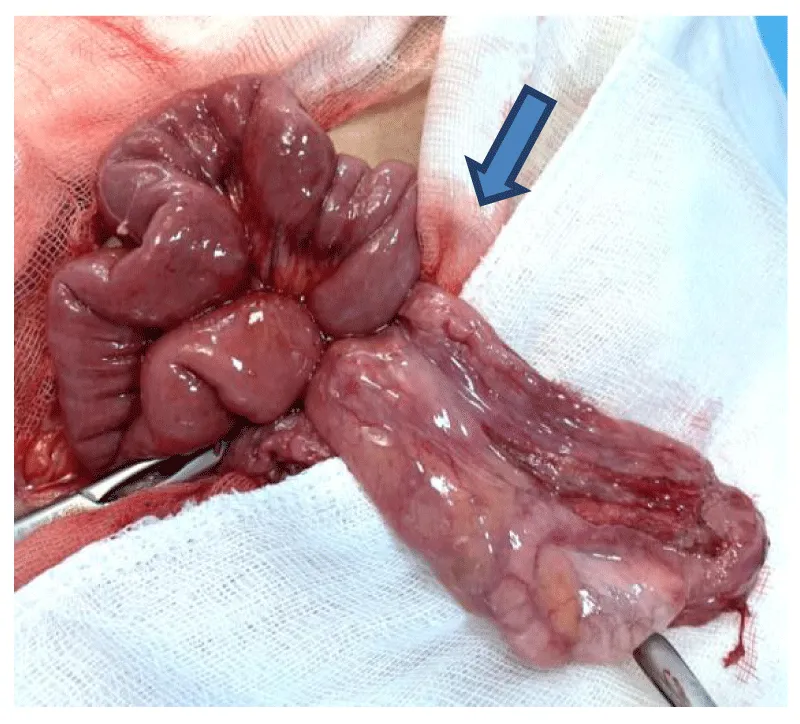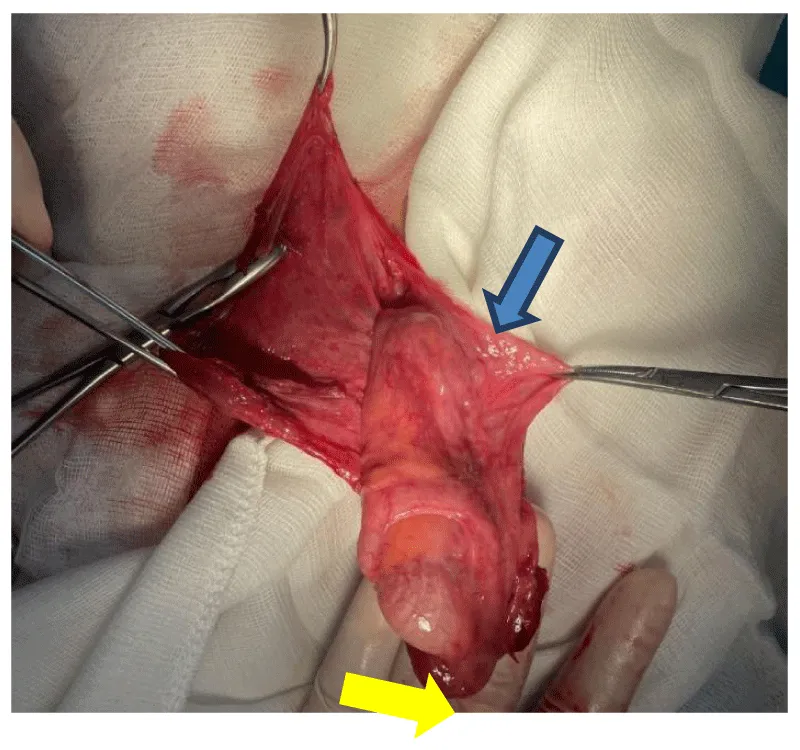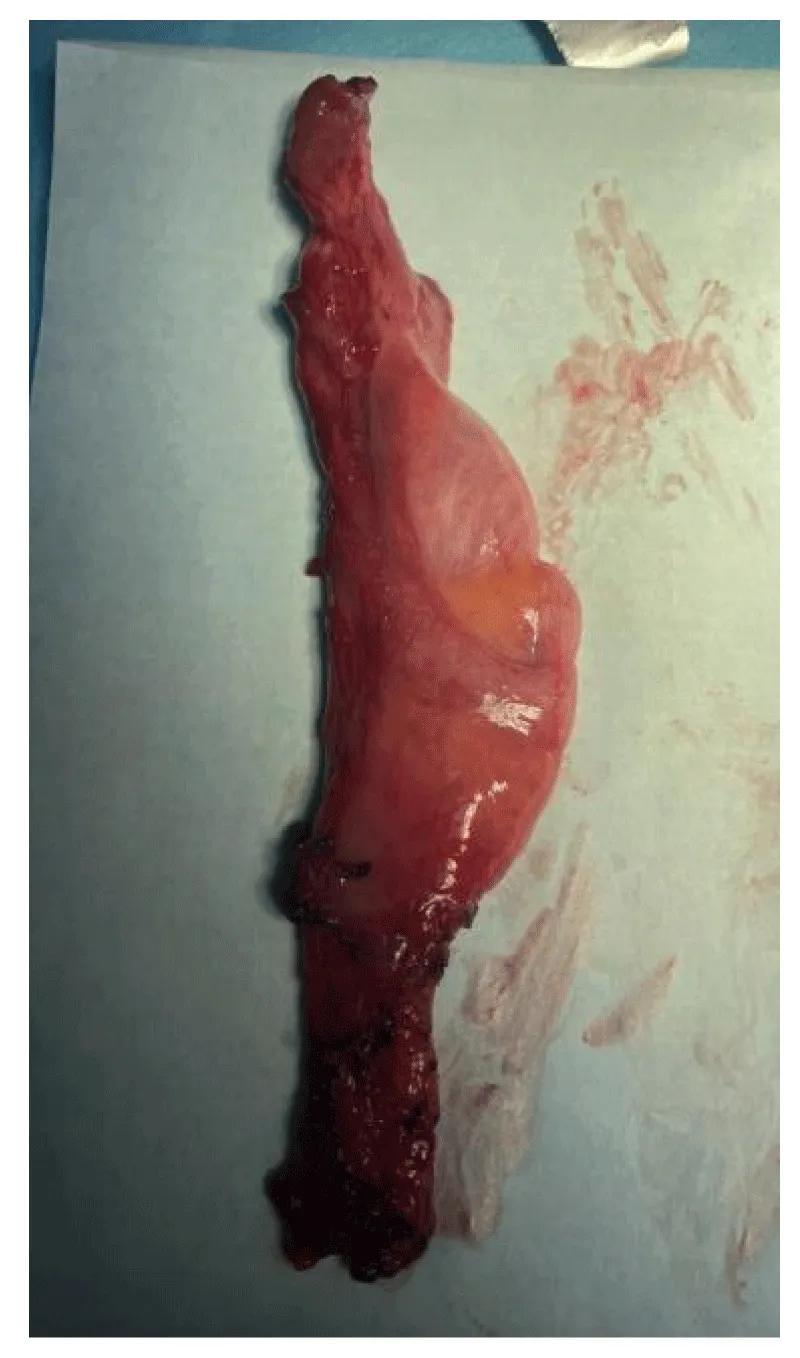Journal of Surgery and Surgical Research
Surgical management of an elderly patient with strangulated inguinal hernia and cryptorchidism: A case report
Med Dheker Touati1,2*, Mohamed Raouf Ben Othmane1,2, Firas Jaouad1,2, Fahd Khefacha1,2, Anis Belhadj1,2, Ahmed Saidani1,2 and Faouzi Chebbi1,2
2Faculty of Medicine of Tunis, University of Tunis El Manar, R534+F9H, Street of the Faculty of Medicine, Tunis, Tunisia
Cite this as
Touati MD, Ben Othmane MR, Jaouad F, Khefacha F, Belhadj A, et al. (2023) Surgical management of an elderly patient with strangulated inguinal hernia and cryptorchidism: A case report. J Surg Surgical Res 9(2): 015-017. DOI: 10.17352/2455-2968.000158Copyright
© 2023 Touati MD, et al. This is an open-access article distributed under the terms of the Creative Commons Attribution License, which permits unrestricted use, distribution, and reproduction in any medium, provided the original author and source are credited.Cryptorchidism, the condition of undescended testicles, and inguinal hernia share a common embryological origin, often presenting together. This case report describes the surgical intervention for a 73-year-old diabetic male with a 20-year history of left inguinal hernia and a single right testicle. The patient presented to the emergency department due to obstructed inguinal hernia, reporting pain, bowel obstruction, abdominal distension, and vomiting. Physical examination revealed a left inguinal hernia measuring 10 cm, which was incarcerated, non-expansile, and irreducible. Intraoperative exploration unveiled a strangulated oblique external left inguinal hernia with a 10 cm sac and a narrow neck containing an ischemic, yet non-necrotic, small bowel. Orchidectomy was performed due to testicular atrophy. The hernia repair utilized the Lichtenstein technique with a polypropylene mesh. Postoperatively, the patient recovered well without complications. Follow-up at 5 months showed no hernia recurrence or mesh infection. This case highlights the importance of timely surgical intervention in managing complex cases of hernia and cryptorchidism, particularly in elderly patients, and underscores the significance of careful intraoperative decision-making for optimal patient outcomes.
Introduction
Cryptorchidism, also known as undescended testicle, is a condition where one or both testicles fail to descend into the scrotum [1]. The relationship between inguinal hernia and cryptorchidism is due to a shared embryological origin. During fetal development, the testicles descend from the abdomen into the scrotum through the inguinal canal [2]. This is why the association between inguinal hernia and cryptorchidism is relatively common. However, it is rare when discovered in an elderly patient, as in the case of our report.
Case report
This is a 73-year-old patient, diabetic on metformin, with no surgical history. He has been a known carrier of a left inguinal hernia for 20 years and has a single right testicle, but has never sought medical attention for cryptorchidism or his inguinal hernia. He has had two children. The patient presented to the emergency department of our hospital due to a change in the character of his hernia in the past 5 hours before admission. The hernia became painful, associated with a cessation of bowel movements and gas, abdominal distension, and vomiting.
Upon examination, the patient had a blood pressure of 120/80 mmHg, tachycardia with a pulse of 100 bpm, afebrile, and a slightly distended abdomen. The examination revealed a left inguinal hernia measuring 10 cm, incarcerated, non-expansile, non-pulsatile with coughing, and irreducible. Laboratory tests showed no abnormalities. The decision was made to operate on the patient via a left inguinal approach.
Upon exploration, it was found to be a strangulated oblique external left inguinal hernia with a 10 cm sac and a narrow neck of 1 cm, containing approximately 25 cm of ischemic bowel, but the bowel was not gangrenous (Figure 1). After widening the neck, the bowel quickly regained a pink color and peristalsis. During exploration, a spermatic cord with an atrophied left testicle in the hernia sac was discovered (Figure 2). It was decided to perform an orchidectomy due to testicular atrophy with epididymal edema (Figure 3). No bowel resection was necessary, and the procedure concluded with a Lichtenstein technique-based repair using a 10*12 cm polypropylene mesh.
Postoperative recovery was uneventful, with the patient regaining bowel function on day 2 and being discharged on day 3 postoperatively. During follow-up at the outpatient clinic, the patient showed no hernia recurrence or infection of the mesh at 5 months postoperatively.
Postoperative recovery was uneventful, with the patient regaining bowel function on day 2 and being discharged on day 3 postoperatively. During follow-up at the outpatient clinic, the patient showed no hernia recurrence or infection of the mesh at 5 months postoperatively.
The pathological examination concluded with an atrophic testicle without identified signs of malignancy.
Discussion
Undescended testis is the most common genital malformation in male infants, impacting 2 to 5% of full-term boys and up to one-third of premature boys. Early intervention is always advisable for this condition [3].
Disturbances in the regulatory mechanism of hormones and peptides influencing testicular descent can result in various structural abnormalities, including incomplete or absence of the inguinal canal, absence or underdeveloped gubernaculum, cryptorchidism, and atypical hernia presentations such as Spigelian hernias and sliding inguinal hernias [4].
The association between inguinal hernia and cryptorchidism is significant, with about 90% of undescended testes being associated with a persistent processus vaginalis, which can lead to an inguinal hernia [5].
While undescended testis is typically diagnosed in early childhood, there are occasional instances of late diagnoses, even in adults.
Late treatment poses significant complications, primarily affecting fertility and elevating the risk of testicular malignancy [3].
A case from the literature observed that an undescended testicle was associated with a strangulated inguinal hernia, resulting in the strangulation of the testicle due to constriction at the neck of the sac [6].
Cryptorchidism and inguinal hernia are frequently associated pathologies that may require surgical treatment. In the case of cryptorchidism, orchidectomy must be performed in adults given the risk of malignancy. The treatment of the hernia may consist of a herniorrhaphy or a mesh repair.
Conclusion
Cryptorchidism is a prevalent congenital condition usually diagnosed and managed during childhood. Consequently, it is infrequently identified in adults and is notably rare among elderly patients.
The treatment of inguinal hernia and cryptorchidism, which are generally associated, is mostly surgical. It is recognized to be linked with neoplasms in undescended testes, that’s why orchiectomy is advised for adult patients.
Patient consent
Written informed consent was obtained from the patient for the publication of this case report and its accompanying images. A copy of the written consent is available for the Editor-in-Chief of this journal to review upon request.
Data availability: The data supporting this case report are available upon request from the corresponding author.
- Fujishima H, Sasaki A, Takeuchi Y, Morimoto A, Inomata M. Laparoscopic treatment for inguinal hernia combined with cryptorchidism: Totally extraperitoneal repair with orchiectomy under the same operative view. Int J Surg Case Rep. 2015;17:79-81. doi: 10.1016/j.ijscr.2015.10.029. Epub 2015 Nov 2. PMID: 26581081; PMCID: PMC4701809.
- Undescended Testicle Causes and Treatment | UPMC. UPMC | Life Changing Medicine. [cité 17 déc 2023]. Disponible sur: https://www.upmc.com/services/urology/conditions/undescended-testicle
- Sepúlveda L, Gorgala T, Lage J, Monteiro A, Rodrigues F. Undescended Testis Presenting as Incarcerated Inguinal Hernia in Adults: A Rare Case and Literature Review. Curr Urol. 2014 Oct;7(4):214-6. doi: 10.1159/000365680. Epub 2014 Aug 20. PMID: 26195955; PMCID: PMC4483298.
- Arslan Y, Karaman K, Altintoprak F, Kahyaoglu Z, Zengin I, Uzunoglu MY, Demir H. Indirect inguinal hernia sac containing testis and spermatic cord in an adult patient with cryptorchidism. J Surg Case Rep. 2014 Mar 7;2014(3):rju017. doi: 10.1093/jscr/rju017. PMID: 24876399; PMCID: PMC4197921.
- Zuiki T, Ohki J, Komatsubara T, Lefor AK, Miyahara Y, Ochi M, Hirota N. An inguinal hernia with cryptorchidism with a Leydig cell tumor in an elderly man: A case report. Int J Surg Case Rep. 2017; 31:193-196. doi: 10.1016/j.ijscr.2017.01.048. Epub 2017 Jan 23. PMID: 28171846; PMCID: PMC5295633.
- Muqueem K, Kasa S, Patil N, Harsoori MM. Strangulated Interstitial Hernia with Strangulated Cryptorchid Testis-First Case Report in the Medical Literature. Indian J Surg. 2018 Apr;80(2):184-186. doi: 10.1007/s12262-018-1729-0. Epub 2018 Feb 8. PMID: 29915485; PMCID: PMC5991019.
Article Alerts
Subscribe to our articles alerts and stay tuned.
 This work is licensed under a Creative Commons Attribution 4.0 International License.
This work is licensed under a Creative Commons Attribution 4.0 International License.





 Save to Mendeley
Save to Mendeley
